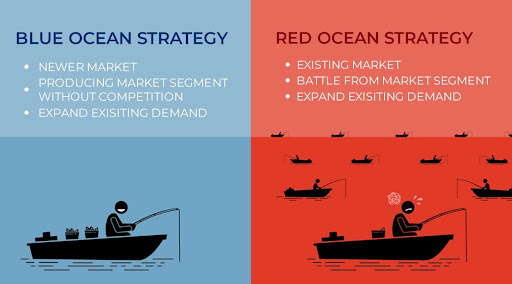
The Greek military leader and historian Xenophon coined the term "strategy" in the fourth century BC. The term literally translates to "the art of the general." From the Greek (stratos, "army") and (agein," "to gather") derives the term "stratagem" (to lead). Strategy is typically used to refer to a long-term plan to achieve a goal or set of goals. It is often used in the context of business, politics, and military operations. In this blog, I would like to set a business context for the reader's clarity.
A company's business strategy is its long-term plan to achieve its aims. It is a long-term strategy for beating the competition in a certain market or set of sectors. A company plan will normally consist of a comprehensive study of the market, a defined long-term goal, and a set of steps to get there. The plan lays out the organization's long-term objectives, strategies, and tactics for achieving and sustaining an edge in the market.
Primarily there are two bifurcation in the Strategical approach purely based on the Market ground, which associated with customer experiences. They are Blue Ocean Strategy and Red Ocean Strategy. Both are two distinct approaches that a corporation may take in order to maintain their position as market leaders in their particular sector. W. Chan Kim and Renée Mauborgne, both professors at the French business school INSEAD, are credited with developing the idea that is now known as "Blue Ocean Strategy." The goal of the strategy is to carve out a new segment of the market by developing a product or service that other businesses in the field do not provide. When a corporation does this, it might lessen the amount of competition and generate new demand.
The primary distinction between the two methods is that the Blue Ocean Strategy is centred on the process of developing new demand, while the Red Ocean Strategy is centred on the process of competing within an existing market. The Blue Ocean Strategy calls for a firm to develop a product or service that fills a gap in the market by providing something that is not already being provided by other businesses in the same sector.
A few examples on Blue Ocean Strategy company were successful,
- The iPhone by Apple: This product single-handedly reshaped the mobile phone market. Apple paved the way for a whole new market for smartphones by prioritizing design, user experience, and content. Apple's sales, profits, and market share have grown a lot in the past few years. The company's sales went from $18.3 billion in 2007 to $265.6 billion in 2019, and its profits went from $1.84 billion to $55.3 billion over the same time period. Apple's share of the global smartphone market has also grown a lot, from about 2.4% in 2007 to 18.8% in 2019.
- Amazon introduced a new market by providing users with an online marketplace to buy and sell products and services. E-commerce and the proliferation of online marketplaces like Amazon are both results of the company's meteoric ascent to prominence. Their success with the Blue Ocean Strategy. According to a study by McKinsey, Amazon's market capitalization has grown by $445 billion since the start of its Blue Ocean Strategy in 2004.
- Tesla was an early leader in the field of electric vehicles. Tesla has opened up a whole new market for EVs because to its emphasis on technological innovation and environmental consciousness. Interestingly, Statista says that Tesla's market capitalization will grow from $37 billion in 2016 to $630 billion in 2021, or at a rate of 78.9% per year. In 2020, Tesla will sell a total of 499,550 cars, which is 40.5% more than in 2019. In 2020, the company's income went up by 36.9%, to $31.5 billion. Also, Tesla's net income went from $1.1 billion in 2019 to $3.7 billion in 2020, which is more than a tripling.
- Netflix is responsible for revolutionizing the method in which people view movies and television programs by introducing a streaming service that is based on subscriptions. Netflix was able to enter a whole new market as a result of this, in addition to expanding its client base significantly.
On the other side, the Red Ocean Strategy focuses on competing within the current market space by finding methods to separate itself from the other businesses that are already in the market. Companies that use this approach have as their primary objective the acquisition of market share from their rivals by lowering their pricing and increasing the number of features they provide. A few examples on Red Ocean Strategy adapted successfully most of the organization,
- Product differentiation refers to the process by which businesses work to distinguish themselves from their rivals by generating distinctive goods and services that stand out from the crowd (eg. Any Consumer Appliances products)
- Price wars occur when businesses that compete with one another cut their prices in an effort to increase their share of the market. (eg, Any FMCG products)
- Companies often buy or combine with other businesses in order to expand their market share and, therefore, their earnings. This may be accomplished via mergers and acquisitions.
- Market penetration refers to the process through which businesses gain their market share by using aggressive advertising and sales strategies.
The Blue Ocean Strategy is often seen as the more forward-thinking method since it enables businesses to discover new ways to connect with clients who previously may not have been targeted.
Be it a Blue Ocean or Red Ocean Strategy, it really matters for any businesses. Having a good strategy can help businesses set goals, make better decisions, stay competitive, and increase profits. It can also help businesses to identify and capitalize on opportunities, improve operational efficiency, and respond to changes in the market. A well-thought-out strategy can also help businesses to develop effective marketing plans, create customer loyalty, and ultimately achieve their organizational objectives.

